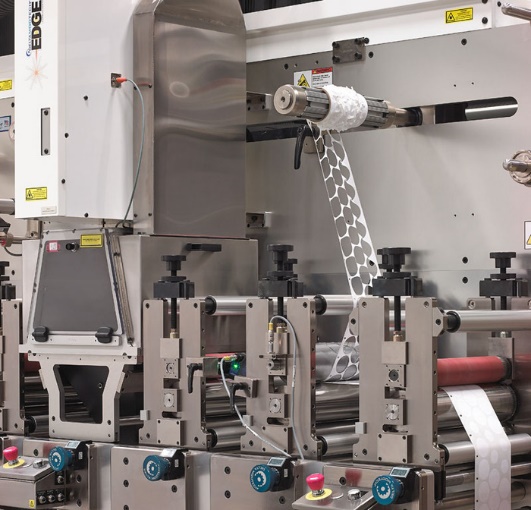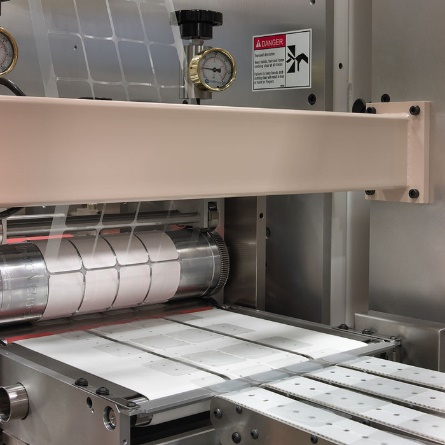Choosing Right: Laser Die Cutting Vs. Rotary Die Cutting
- Published: August 30, 2021
By Dave Grenwis, Marketing Manager at Delta ModTech
Precision vs. durability? Cost vs. quick run capabilities? When comparing laser die cutting to rotary die cutting, there are a variety of reasons to choose one over the other – and a whole lot of grey area in between. Let’s take a closer look at what’s right for your die cutting machine.
Before we break down the pros and cons of each option, let’s start out with a qualifier: The die cutting option you choose will depend entirely on the type of project you’re undertaking. And, as you’ll learn, there are cases when both options can be used.
But before we get to that, and an interview with die cutting expert Todd Wood of Delta ModTech, let’s take a look at some definitions of each option.
 What is laser die cutting?
What is laser die cutting?
Laser die cutting involves using a high-speed laser to cut through substrate. Lasers can be used to make a variety of cuts and do not require any contact with the material.
There are only a few manufacturers of the actual laser used in laser cutting machines.
Types of Laser Cuts
- Ablation
- Kiss cutting
- Through cuts and slug removal
- Perforation
- Drilling
- Slitting
- Scoring
- Scribing and sequential numbering
- Reject marking
Materials used in laser cutting:
- PSA, Polyester, cork, foam, neoprene, silicone, PU, PE, PET, polycarbonate, polyethylene, polypropylene
- Thin foil, metal
- Ablation of metals bonded to polyester or similar substrates
- Abrasives, adhesives, fabric, paper, plastic, rubber, textiles
What is rotary die cutting?
Rotary die cutting involves using a customized, machined part to cut through substrate. Rotary dies can make a variety of cuts, and are known for their durability.
Types of die cuts:
- Metal to metal (also known as thru cutting)
- Kiss cutting
- Perforation
- Scoring
- Slitting
 Materials used in die cutting
Materials used in die cutting
There are many materials that can be rotary die cut. The most common are: paper, film, foam, gaskets, tapes, magnets, tyvek, vinyl, and pouch stock foil. There are many more and it is always best to have your die tooling supplier test each material to verify cutting capability.
The advantages of laser die cutting
What are the advantages of laser die cutting over rotary die cutting? Let’s take a look.
Tough cuts, tight tolerances. The laser’s claim to fame is that it can cut through intricate, tricky patterns in which it would be difficult for a traditional rotary die cutter.
Prototype friendly, quick turnaround. Laser cutting doesn’t require hard tooling, so it’s ideal if you want to create quick prototype. You can then invest in a more durable rotary cut die down the road.
Matches up with a variety of materials. There are a wide range of lasers so they can match up with a variety of materials.
Maintenance / Replacement costs. A rotary die may be less expensive to purchase, but it will eventually become dull and need to be sharpened and replaced. A laser will last significantly longer.
Storage. Rotary dies are heavy and require racks. It will definitely take up space and you’ll need to allocate time to organize the storage.
Flexibility. The laser can be continuously readjusted for quick runs, which is why it’s often the choice of contract converters.
User-friendly. Providing you’re trained properly on the laser’s usage, it should be significantly easier to operate. A rotary die needs to be physically replaced when it wears down, and will require operator training for the replacement process.
New advancements. Laser technology has come a long way, and new advancements are taking place every day. We’ve listed the new lasers on the market, and more appear every day.
Instant verification. You can verify cut tests immediately.
Quicker time to market. You can upload a drawing quickly to a laser cutting machine and beginning cutting. Those recipes and programs can also be saved and easily recalled.
The advantages of rotary die cutting
Let’s take a look at the advantages of rotary die cutting machines in comparison to laser die cutting machines.
Difficult to cut materials. Lasers may struggle with more difficult materials. The rotary die usually cuts through any substrate at approximately the same speed. The laser speed will be dependent on the cut pattern.
Big runs. A rotary die is better for handling big production runs, as it can cut at a faster rate and ultimately a lower cost.
Less upfront costs. A rotary die cutting machine is less expensive to purchase.
Speeds. Laser cutting moves at a slower pace. It has to adjust its cutting speed and depth with each cut, where the shape is already in the rotary die.
Rotary die cutting vs. laser cutting
Both rotary die cutting and laser cutting have advantages based on specific situations. We decided to compare them based on the various needs we see in rotary die cutting:
|
Advantage: |
Advantage: |
|
|
Laser Die Cutting |
Rotary Die Cutting |
|
|
|
|
|
|
Tough cuts, tight tolerances |
X |
|
|
Difficult to cut materials |
|
X |
|
Prototype friendly, quick turnaround |
X |
|
|
Matches up with a variety of materials |
X |
|
|
Maintenance / replacement costs |
X |
|
|
Big runs |
|
X |
|
Less upfront costs |
|
X |
|
Storage |
X |
|
|
Flexibility |
X |
|
|
User-friendly |
X |
|
|
Speeds |
|
X |
|
New advancements |
X |
|
|
Instant verification |
X |
|
|
Quicker time to market |
X |
|
The decision is in the details
Even though there appear to be many more strengths to laser cutting than die cutting, it’s not always going to be an automatic choice. Ultimately, your decision will be driven by the project goals, costs and time constraints. It brings us back to our number one point of emphasis: When you establish effective R&D and concrete goals upfront, it allows a converting machine manufacturer to provide the best solution.



